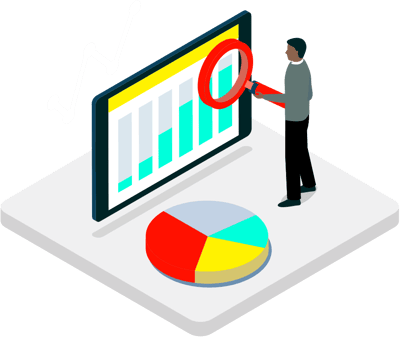
An Ultimate Guide to Perfecting Your Marketing Attribution Reporting
In this guide, we highlight the secrets to effective attribution reporting, dive into reporting within popular platforms, and cover the models your company needs to embrace to supercharge your campaigns.
Chapters
How to Determine Your Company’s Attribution Reporting Readiness
Choosing the Best Attribution Model for Your Company
How to Boost Your Attribution Campaigns in Every Marketing Program
Online vs. Offline Reporting: What’s Best for Your Company?
Conclusion
How to Determine Your Company’s Attribution Reporting Readiness

Basically, attribution reporting is a way of tracking the content and marketing channels that are leading to conversions and sales. Marketing attribution lights up the path your leads and customers walk along as they saunter through the Buyer’s Journey. For marketers, attribution reporting can prove ROI, highlight channels that are driving conversions, and illuminate dead efforts that are worth cutting off.

How mature is your company’s attribution reporting setup?
As critical as attribution reporting is to marketing initiatives, no two companies will be equally equipped to capture the same information—and attribution reporting comes in all shapes and sizes. The maturity of your company’s multi-touch attribution reporting abilities will dictate how you’ll want to move forward.
Here’s how to determine your company’s attribution reporting maturity level:
- Low maturity
- Moderate maturity
- High maturity
- Overly complicated
Low Maturity
If your company is just starting to kick off marketing attribution reporting, it probably falls in the low-maturity category. In this stage, your team might use basic tools such as Google Analytics and out-of-the-box reporting. You might also be tracking closed customers back to your analytic platform. However, if you’re at a low level of maturity, the company probably isn’t tracking many sales touchpoints along the way.
Moderate Maturity
Companies with moderate attribution reporting usually have tracking codes laid out for the most important offline and online interactions. You may have stepped past simple, out-of-the-box tracking and set up reports for some touchpoints. You might also be using your customer relationship management (CRM) tool or other technology to completely track your marketing and sales funnel. However, at this stage, you probably have gaps that don’t cover offline interactions or data from your sales software.
High Maturity
Marketing teams with high reporting attribution maturity track the full scope of both online and offline activity. At this stage, you’re measuring and building attribution reports on all of your interactions. It also means your marketing and sales teams are completely on the same page when it comes to tracking actions and goals.
Overly Complicated
More tracking doesn’t necessarily equal more mature attribution reporting. Many companies, especially enterprises with siloed departments, will have an abundance of tracking codes and little idea what they’re for. These teams may be tracking interactions, but they’re tangled, messy, and not feeding into clear reporting.
What technology will enhance your multi-touch attribution?
There is technology that can simplify your multi-touch attribution efforts and lift the burden off your marketers. Here are a few helpful tools and some technology to simplify your attribution efforts:
LeadsRX is fairly straightforward and includes simple installation. That makes it especially useful for small and mid-sized businesses that need to simplify their multi-touch attribution reporting. Once the tool is set up, you unlock several attribution tools, including the following:
- Analytics data
- Customer journey mapping
- Segmentation
As a whole, LeadsRX is a sturdy addition for both B2B and B2C marketers who want to streamline their marketing attribution efforts.

Terminus is best known as a tool for B2B marketers, but it also includes dashboards that present numbers in an easy-to-understand layout. A big advantage of Terminus is that it’s built with a range of integrations so you can easily weave an unbroken web within your tech stack. Some popular integrations include:
- Salesforce
- HubSpot
- Marketo
- Bombora
Terminus is also well known for its customer support features, and the company even offers training programs.
CAKE is a versatile tool, crafted for businesses of all sizes. Although it doesn’t include audience segmentation, it does lay out handy tracking features, such as cross-channel attribution reporting and ROI tracking. CAKE is another company known for stellar support. It offers 24/7 customer service, as well as in-person training options.
Choosing the Best Attribution Model for Your Company

The success of your attribution reporting depends on how well your team can line up marketing goals with crisp reporting. First, that means your company needs to pick the right attribution model to accomplish your goals.
Wondering what models are available? Here are some popular attribution models:
- First touch
- Last touch
- 50/50
- Time decay
- Linear
- U-shaped
- W-shaped
First Touch
In first-touch attribution models, you weigh the credit fully on that first-touch interaction. This is especially useful for companies that are trying to discover which content is pulling in leads. Because it shows you what channels and content is capturing the most attention, first-touch models can reveal which areas are producing leads and which efforts are worth ditching.
Last Touch
In last-touch attribution models, all of the credit goes to the last touchpoint your prospect hits before they are converted. Implementing the last-touch model is a great way to shed light on what is inspiring customers to act. This model is especially helpful for companies that are churning out plenty of leads but having a tough time turning those leads into conversions. Because you can pinpoint that last contact point, last-touch models make it easy to see which strategies and channels are pushing contacts along, and which ones are failing to convert.
50/50
To set up a 50/50 attribution model, you’ll want to divide credit evenly between your first touchpoint and the last touchpoint that comes before lead creation. Essentially, this model weighs your attention-grabbing step and action step evenly. That makes it easier to gauge your marketing efforts on a broader scale.
Time Decay
Time decay models divvy credit up among all of your touchpoints along the customer journey or your conversion path. As the name suggests, this model gives more weight to those touchpoints closest to a sale. This is a good model if you have a solid lead generation engine but are having a tough time pushing leads down the funnel. When it comes to the Buyer’s Journey, a time decay model is built to identify prospects in the consideration and conversion stages.
Linear
In a linear model, you divvy credit up evenly along all of your touchpoints. This is a handy model when you want to set goals and boost transparency. It reveals the channels or interactions that contribute to a sale that may otherwise be overlooked.
U-Shaped
In a u-shaped model, 80 percent of credit is divided equally between your first touch and lead creation. The rest of your credit goes to all of those touchpoints that fall between those two milestones. This model is best for measuring lead generation attribution.
W-Shaped
When your attribution reporting is w-shaped, you divide credit evenly between three touchpoints: first touch, lead creation, and qualified lead. Because it’s stretched evenly across milestones, this model illuminates the broader story of your campaigns.
How should you choose the right attribution model for your company?

When it comes to picking the right marketing attribution reporting method for your company, there isn’t a cookie-cutter solution. In some cases, you may want to mix and match several models based on your buyer personas and the Buyer’s Journey.
Above all else, your attribution model should fit your goals, capitalize on your current marketing strengths, and fill in any reporting gaps. Here are some questions to help you pick out the right attribution model for your business:
- What is the biggest weakness in our current marketing attribution program?
- What are our biggest strengths?
- Which resources have sparked the most leads?
- Which channels are leading to the most sales?
- What areas of our funnel need extra attention?
By digging into your current strengths, weaknesses, and goals, you’ll be able to line your needs up with the model or models that reveal everything you need to fuel the best marketing attribution reporting.
How to Boost Your Attribution Campaigns in Every Marketing Program

Today’s marketers have a massive selection of tools at their disposal. Unfortunately, each marketing platform comes with its own set of best practices, features, and benefits. If you want to get the most out of your attribution campaign, you need to know how to use the platforms your company has on hand. Here’s a quick guide to marketing attribution in popular marketing programs:
HubSpot
HubSpot has built-in functions made specifically to boost your marketing attribution reporting capabilities. In fact, HubSpot has two separate types of multi-touch attribution reports: multi-touch contact attribution and multi-touch revenue attribution.
Wondering how HubSpot’s multi-touch reports are set up? Here are the touchpoints HubSpot’s reporting hinges on:
- First interaction
- Lead creation
- Deal creation
- Closed-won
You’ll also have access to multi-touch revenue attribution reporting within HubSpot. This lays out the touchpoints that influence a closed deal. These reports are based on the following:
- Interaction source
- Content type
- Deal type
- Campaign
- And other dimensions
In order to set up your attribution reporting in HubSpot, you’ll need access to its Marketing Hub Enterprise, Customer Reporting, and Sales Hub.

Marketo
Marketo is another powerful platform that can boost your team’s attribution reporting success. Marketo gives users three different choices of attribution modes:
- Explicit: This will only count those contact roles that are connected to opportunities.
- Hybrid: When you set up hybrid mode, it will start by searching for a contact role on an opportunity. If it doesn’t find any, it searches for the opportunity company. From there, it will track all your account contacts and lay out their influence.
- Implicit: This mode starts by examining the opportunity company. Next, it will track down account contacts and measure their influence.
When you’re building your Marketo reporting, there are three important best practices to guide your actions:
- Match channels to success steps: Before you do anything else, you’ll want to assign every channel you have to a success step.
- Match users to programs: Be sure that all of your users are added to the corresponding Marketo program.
- Attach opportunities to contacts: Be sure to attach an appropriate opportunity to your contact. Otherwise, Marketo won’t be able to assign your first-touch or multi-touch attribution accurately.
.jpg?width=200&height=63&name=bizible-logo%20(1).jpg)
Bizible
Bizible is best known for its Google Ads for Salesforce replacement feature, but it has become a force in the B2B campaign world recently—and it’s connected to both Adobe and Marketo. Bizible provides six different multi-touch attribution models:
- First touch
- Last touch
- Full path
- W-shaped
- U-shaped
- Custom
It’s important to note that Bizible is made for enterprise-level businesses. It’s set up to cater to account-based marketing (ABM) campaigns, it includes advanced closed-loop reporting functions, and it features high-level dashboards.
Salesforce
Salesforce is less known for its marketing reporting, but it’s still both powerful and flexible. It offers several out-of-the-box options for marketers who want to map out attribution reporting.
Here are a few of the key reporting features Salesforce offers:
- Opportunity lead source: This clear drop-down system makes it easy to see the source your lead came from when they were pulled into your system. This helps you pinpoint a customer or prospect’s key touchpoints and actions.
- Urchin tracking module (UTM) tracking: UTM tracking lets you tag your URLs with small descriptive snippets. That way, you can see the sources, campaigns, and other details describing where your traffic is coming from.
- Salesforce campaigns: With Salesforce campaigns, you’ll see who has been hit with marketing messages and how they’re reacting.

LeanData
LeanData is a solid option if you want to link up Salesforce accounts and pin down campaign attribution reports. As a whole, there are three key features to take advantage of when using LeanData to build marketing attribution campaigns:
- Campaign Influence Wizard: Within LeanData’s Campaign Influence Wizard, you can control fields, filter objects, and set up custom models to direct your attribution efforts. You can also feed Salesforce data into your tool, and that info will run natively in Salesforce.
- Opportunity View: With the Opportunity View feature, you can track your prospect and customer’s interactions. This makes it easy to follow leads as they wander across different opportunity levels.
- Campaign View: Use Campaign View to dive into the individual touches a person makes on the Buyer’s Journey. This feature lets you report on impressions from different campaigns and channels.
Google and Paid Media
When it comes to paid ads, clear attribution reporting plays a key role. By mastering your attribution efforts in programs like Google Ads, YouTube, and Facebook, you can prove ROI and see where your investments are paying off. Here’s an overview of attribution reporting on these different paid platforms.

Google Ads
Google Ads is one of the most popular paid platforms out there. When it comes to tracking activity, Google’s attribution is session-based. It uses cookies to track conversions and touchpoints. Google gives you several options when it comes to attribution reporting, including First Click, Last Click, Time Decay, Linear, Position Based, and Data-Driven.
![]()
YouTube
Google Ads now lets you use YouTube to track attribution reporting. YouTube uses a data-driven model that measures clicks as well as video engagements. You can also use YouTube attribution to measure how well ads run and how they relate to search campaigns.
![]()
Unlike Google, Facebook only tracks activity when users are logged in. That means they’ll be measured differently from Google’s session-based reporting. As a default, Facebook provides a last-touch attribution model. However, default reporting is restricted to a 28-day window. Within Facebook’s attribution reporting, you have the option of tracking performance reporting along everything from organic and paid interactions to direct interactions. You can also track custom reports by group or access cross-device reporting.
Online vs. Offline Reporting: What’s Best for Your Company?

In today’s marketing world, your customers will certainly be interacting online. After all, more than four billion people are now actively surfing the web. However, many companies still have offline marketing interactions that you’ll want to track and credit.
The key is striking the right balance between reporting on all of your offline and online marketing interactions. The first step is understanding each piece of your marketing puzzle and how both online and offline reporting fits into your company’s goals.

What is online marketing attribution reporting?
Online marketing attribution includes your company’s website, along with all of those digital touchpoints that carry leads through an online path. Here are a few examples of online marketing touchpoints:
- Blogs
- Case studies
- Social media posts
- Online ads

What is offline marketing attribution reporting?
Offline marketing attribution reporting analyzes the interactions and actions your potential customers take offline. There may be more offline marketing touchpoints built into your operation than you realize. Here are some common offline attribution paths:
- Point-of-sale data
- Foot traffic
- Tradeshow and event traffic
- Panel data and source matching
Again, the data should guide your efforts. In order to get the most out of your marketing attribution reporting and boost marketing and sales alignment, make sure your company is fully covered. Start by identifying all of your online and offline marketing and sales sources. From there, examine your marketing goals, choose the right attribution model to boost your efforts, and bridge the gap between online and offline reporting.
Once your marketing team has a steady stream of attribution reporting flowing in across online and offline sources, you’ll have what you need to capture more leads, prove ROI, and drive more sales.
Conclusion

The more time your team spends perfecting your attribution reporting, the easier it will be to capture leads, convert them, and drive more sales. The best attribution reporting plan will help you align the vision of your whole team. By refining your marketing attribution plan, you’ll lay the groundwork for a more unified company, build out more wide-sweeping support, and pave a clear path toward your team’s marketing goals.
When you unlock clean, efficient attribution reporting, you’ll be able to:
- Prove marketing ROI
- Pull in more buy-in and resources from stakeholders
- Patch the holes in your marketing funnel
- Capitalize on the strengths of your current marketing strategy
- Drive more leads to your site
- Boost conversion rates
Ready to kick off masterful marketing attribution reporting? Start now by determining your company’s abilities and needs. Take our Hubspot Attribution Reporting Readiness Assessment to get started.





